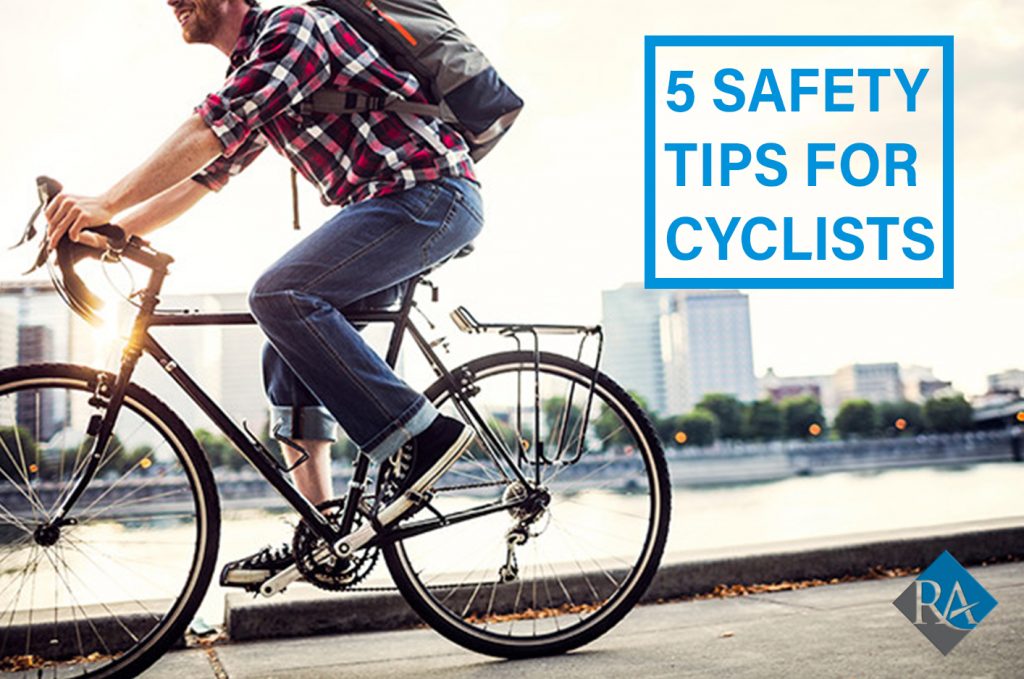
06 Apr 5 Tips to Ensure a Safe Bicycle Season
Spring is here and cycling enthusiasts are heading back out on the road for another season. Unfortunately, with them comes an increase in cycling accidents. Here are five tips for cyclists to stay safe as they return to shoulders and lanes around Southern California.
Start Every Ride (and Season) With an ABC Check
Before every ride, and especially your first ride of the season, check off your ABCs: Air, Brakes, and Chain. If your bike has been sitting in the garage for a while, take it to a certified bike repair shop for a pre-season tune. While you’re there, if necessary, ask the technician to refresh you on the basics of the ABCs:
Air: Bike tires lose their ideal air pressure relatively quickly and for all sorts of reasons, from temperature fluctuations to seepage from valves. As Cycling Weekly reminds us, at the start of every ride, the pressure in your tires should be suitable for the tires you’re riding on, the weight they’re carrying, and the style of riding you do. If you don’t have a pump, buy one and learn to operate it. While you’re at it, get to know the mechanics of your bike’s air valves.
Brakes: It sounds obvious, but you should always check to make sure your brakes work. When you squeeze your brake levers, they should engage the brake pads on both sides of the corresponding wheel. Conversely, when the brake levers are disengaged, the pads should be free of the wheel through a full rotation. Make sure the brakes don’t stick, and that cables are not obviously frayed or broken. See a technician to make any needed adjustments (that is, unless this video from Cycling Weekly doesn’t seem too complicated).
Chain: Your chain should be clean of grit and debris, properly lubricated, and at the correct tension (not too loose as to slip from the gears, not too tight as to break). Rusty or damaged chains should be replaced immediately as they can wreak havoc on your gears and your body. Here is a comprehensive guide to maintaining your chain.
Protect Your Noggin
Riding a bike without a helmet is dangerous (and if you’re under 18, it’s against the law in California). Your head can take a dangerous impact on even the simplest spill from a bike (think, tipping over while at a red light). Helmets are relatively inexpensive for the literally vital protection that they provide.
If you have a helmet, make sure it’s in good condition (no cracks, lining in good shape) before you ride and that it fits your head correctly. If you whacked your helmet during a ride last season, the safest route is to replace it.
Wear Clothing That is Visible
When sharing a road with cars and trucks, bicyclists must remember that their visual profile is quite small compared to other wheeled vehicles. An attentive driver can still easily miss an approaching cyclist in her rearview mirror if the rider isn’t wearing colors that stand out.
If you suit up for your ride in a bike jersey, then choose one that’s brightly colored – favor fluorescents over natural tones. If you ride in your everyday clothes, don a lightweight safety vest (the type road workers wear) to make yourself more visible. In short, don’t risk blending in with the background. Your life can depend on it.
Act Like a Car
As a general rule under California law, when riding a bike in a public way you must obey the same traffic laws as any other vehicle. That means you must stop at stop signs and red lights. You must signal your turns. You must obey lane markings. This link from the California Bicycle Coalition outlines your obligations in detail. Get to know them.
Ride in the Direction of Traffic, and Avoid Heavy Traffic if Possible
This tip goes with the one above, but it bears extra attention. In California, you must ride in the same direction as traffic. Riding against traffic is illegal and dangerous. Also, if possible, stay away from heavy traffic. Bike accidents often happen when traffic prevents drivers from giving cyclists space, and vice versa.
Following the tips above will go a long way toward protecting yourself against cycling accidents and injuries this Spring. But, sometimes accidents still happen to conscientious cyclists. When they do, it’s important to know your legal rights to compensation and insurance coverage. An experienced personal injury attorney can help.
At RA & Associates, we represent Southern Californians who have been injured in bicycle accidents. If you have been injured in a biking accident, contact us today.
Contact:
RA & Associates, APC
1 (888) 417-1080
info@raandassociates.com/blog
505 N. Brand Blvd.
Glendale, CA 91203

Sorry, the comment form is closed at this time.